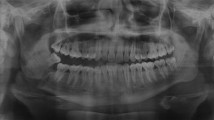Abstract
Purpose
To compare & evaluate postoperative complications & treatment outcome in mandibular fracture fixation using 2.0 mm titanium miniplates & 3-D locking plates.
Method
30 patients were divided randomly into two groups of 15 each (including comminuted & malunited fractures). GROUP A was treated with Open Reduction Internal Fixation (ORIF) using 2.0 mm miniplates & GROUP B with 3-D locking plates.
Results
A total of five complications were observed in four patients: Implant exposure & infection in miniplate group & postoperative neurosensory deficit, implant failure & implant exposure in 3-D group.
Conclusion
For fractures in symphysis & parasymphysis region, severely displaced angle fractures and for comminuted fractures 3-D locking plate could be a better option. In the angle & body region a single miniplate fixed according to Champy’s technique is easy to place with less surgical time, less surgical trauma, is more economical & has similar clinical results.








Similar content being viewed by others
References
Spiessl B (1972) Rigid internal fixation of fractures of lower jaw. Reconstr Surg Traumtol 13:124–140
Champy M, Lodde JP, Schmitt R et al (1978) Mandibular osteosynthesis by miniature screwed plates via a buccal approach. J Maxillofac Surg 6:14–21
Michelet FX, Deymes J, Dessus B (1973) Osteosynthesis with miniaturized screwed plates in maxillofacial Surgery. J Maxillofac Surg 1:79
Cawood JL (1985) Small plate osteosynthesis of mandibular fractures. Br J Oral Maxillofac Surg 23:77–91
Kroon HM, Mathison M, Cordey JR, Rahn BR (1991) The use of miniplates in mandibular fractures. J Craniomaxillofac Surg 19:199
Farmand M (1995) Three-dimensional plate fixation of fractures and osteotomies. Facial Plast Surg Clin North Am 3(1):39–56
Gutwald R, Alpert B, Schmelzeisen R (2003) Principle & stability of locking plates. Keio J Med 52:21
Coletti DP, Caccamese JF, Norby C et al (2007) Comparative analysis of the threaded & tapered locking reconstruction plates. J Oral Maxillofac Surg 65:2587
Guimond C, Johnson J, Marchena J (2005) Fixation of mandibular angle fractures with a 2.0 mm 3-dimensional curved angle strut plate. J Oral Maxillofac Surg 63:209
Collins CP, Leonard GP, Tolas A et al (2004) A prospective randomized clinical trial comparing 2.0 mm locking plates to 2.0 mm standard plates in treatment of mandible fractures. J Oral Maxillofac Surg 62:1392
Ellis E, Graham J (2002) Use of a 2.0-mm locking plate/screw system for mandibular fracture surgery. J Oral Maxillofac Surg 60:642
Wittenberg JM, Mukherjee DP, Smith BR, Kruse RN (1997) Biomechanical evaluation of new fixation devices for mandibular angle fractures. Int J Oral Maxillofac Surg 26:68–73
Bui P, Demian N, Beetar P (2009) Infection rate in mandibular angle fractures treated with a 2.0 mm 8-hole curved strut plate. J Oral Maxillofac Surg 67:804–808
Parmar S, Menat S, Raghani M, Kapadia T (2007) Three dimensional miniplate rigid fixation in fracture mandible. J Maxillofac Oral Surg 6(2):14
Author information
Authors and Affiliations
Corresponding author
Rights and permissions
About this article
Cite this article
Goyal, M., Marya, K., Chawla, S. et al. Mandibular Osteosynthesis: A Comparative Evaluation of Two Different Fixation Systems Using 2.0 mm Titanium Miniplates & 3-D Locking Plates. J. Maxillofac. Oral Surg. 10, 316–320 (2011). https://doi.org/10.1007/s12663-011-0242-9
Received:
Accepted:
Published:
Issue Date:
DOI: https://doi.org/10.1007/s12663-011-0242-9




